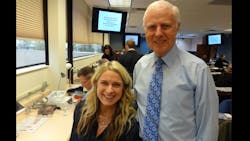Which is best—live or virtual dental CE?
Q: During the COVID-19 lockdowns, I watched virtual continuing education (CE) programs led by you and others. I have mixed feelings about which is best—live or virtual—and what the future holds for the dental profession. What is your opinion on this subject?
A: My formal education has been in psychology, education, and dentistry (prosthodontics). This diverse background has given me the opportunity to critically analyze and develop personal opinions and conclusions for your question. There is no question that most participants enjoy face-to-face courses, the personal interaction they allow, and the ability to easily accomplish hands-on activities.
During COVID-19, I personally provided more than 100 virtual CE programs, ranging from one-hour to two-day courses and from local meetings to international meetings with thousands of attendees. As required by both the American Dental Association (ADA) and the Academy of General Dentistry (AGD), we had the participants provide course evaluations. The responses have been very interesting!
At the beginning of the pandemic, comments from participants were generally positive because there were no alternatives to virtual courses, but many respondents also stated that live courses are much better. As the virus continued and expanded, most participants resigned themselves to virtual programs despite their stated inferior educational experience.
During the same time, some of my college-age grandchildren had to have virtual education whether they wanted to or not. Their opinions were mixed, related directly to the specific instructors. Some of the instructors provided very good programs, while others had almost no interaction with their students and merely suggested they read a book or article and know everything in those sources. As you have probably noted, some university students across the country have sued their schools for accepting tuition and providing virtual classes without the quality students considered to be adequate education.
The value of virtual education appears to be directly related to the instructor—some good and some pathetic.
Now, let’s discuss dental CE and my candid conclusions about its value to dentistry and to you personally.
Advantages of virtual dental CE
The following advantages are based on my personal observations during thousands of CE hours in the live courses I’ve provided and from our participants’ verbal and written course evaluations.
Travel to the course site is not necessary. Participants can receive virtual CE anywhere the internet is available. Participants who are ill, unable to or not desiring to travel, or prevented from travel due to weather challenges or other circumstances have appreciated the advantages of virtual learning. Staying home also saves an enormous amount of “wasted” travel time. However, some individuals can accomplish significant work on airplanes without the interruptions that are present at their home base.
The virtual participant saves the expense of flights, hotel, and food.
Participants can wear clothing of their choice, without having to consider their outward appearance.
Recorded virtual programs are often saved and available to be observed at the participant’s convenience. Post–COVID-19, this convenience can allow participants to work, be with family, enjoy recreation or any other activity, and still receive the education.
Overall tuition expenses are significantly less for virtual education than for live education.
Many virtual programs offer the benefit of pausing the live lecture to deal with interruptions or repeat missed information. Some course providers record the course so participants can view it again in the future if desired.
Participants have found that note-taking can be simplified by taking screenshots during the lecture.
Limitations of virtual education
The following observations regarding the limitations of virtual courses are based on my personal background in education and psychology.
Physical contact with participants is not possible. Handshaking, eye contact, postural positioning, touch, and smile just don’t happen in virtual programs. Psychologists and laypeople alike know the value of physical contact. It is among the most positive of all interactive activities. The loss of this ability is one of the most significant negatives of virtual education and communication. After providing many virtual courses, I have had very little knowledge about the individuals in the courses or whether they’ve received my intended messages. From my perspective, I have merely been talking to a glass monitor.
The instructor has minimal or no way to visually observe participants. Why does this matter? Instructors of virtual courses are not able to sense the involvement of the participants. Are they listening, reading a newspaper, texting someone, eating, tending a child, cooking breakfast, or something else? The instructor has no idea if participants are understanding the course content or if they are even absent from the program doing some other activity.
Quality virtual education is expensive
A huge misunderstanding exists about the cost of producing a virtual program versus a live program. Many think the instructor merely turns on a computer and talks. Unfortunately, some of the courses you have seen were presented in that pedestrian manner. If you were to see our Practical Clinical Courses and Clinicians Report Foundation technical setups and teams needed to produce a high-quality virtual program, you would be amazed. We have technicians to run the electronic equipment, numerous monitors, and excellent sound equipment. We also have staff members to respond to the chat and question and answer sessions, separate cameras to provide hands-on demonstrations, and additional educators participating in various other geographic locations to avoid the stale “talking head” image of many virtual programs.
The cost to produce a high-quality, effective virtual educational program is many times higher than for a high-quality live program. Many proponents of live courses misunderstand the time, energy, effort, and money it takes to produce a virtual program. Assuming the cost to produce high-quality virtual programs and their relative educational inadequacy, we are led to the conclusion that we should do live programs whenever possible.
Characteristics of a successful live program
Near the top of the so-called educational learning triangle are hands-on courses where participants themselves perform the procedures (figure 3).
The educational differences between live and digital programs are obvious!What will remain virtual in dental CE after COVID-19? What have we learned?
- Short virtual programs are better than longer ones. One to three hours have been best in our experience.
- Hands-on virtual education can be done with participant webcams, but that is expensive, somewhat difficult, and not nearly as effective as live hands-on courses.
- Breaks are needed in virtual courses to reduce the monotony of the programs.
- Chat and question and answer activities are mandatory for effective interaction. This is one of the necessary and valuable aspects of virtual programs. Usually, the questions posted during these sessions can be answered unless there are too many.
- Virtual courses are a valuable concept for those who are unable to attend live programs.
Summary
There is no question that virtual dental CE is a useful concept for some dental subjects, some participants, and some situations, such as COVID-19. But this mode of education has been well proven not to be as effective as live dental CE.
Author’s note: The following educational materials from Practical Clinical Courses offer further resources on this topic for you and your staff.
One-hour videos:
- Cementing Restorations—Proven and Successful (Item no. V1921)
- Making Dental Caries Prevention a Win-Win Concept (Item no. V5120)
Live courses:
- Restorative Dentistry 1—Restorative/Esthetic/Preventive with Dr. Gordon Christensen
- Paradigm Changes in the Profession—at the Mirage Las Vegas with Drs. Gordon and Rella Christensen, Gerry Niznick, Harald Heymann, and more
Virtual courses:
- Endodontics—The Untapped Treasure Right Before Your Eyes with John West
- Paradigm Changes in the Profession—condensed with Drs. Gordon and Rella Christensen
For more information, visit pccdental.com or contact Practical Clinical Courses at (800) 223-6569.
Editor's note: This article appeared in the July 2021 print edition of Dental Economics.
Gordon J. Christensen, DDS, PhD, MSD, is a practicing prosthodontist in Provo, Utah. He is the founder and CEO of Practical Clinical Courses, an international continuing education organization founded in 1981 for dental professionals. Dr. Christensen is cofounder (with his wife, Rella Christensen, PhD, RDH) and CEO of Clinicians Report.
About the Author

Gordon J. Christensen, DDS, PhD, MSD
Gordon J. Christensen, DDS, PhD, MSD, is founder and CEO of Practical Clinical Courses and cofounder of Clinicians Report. His wife, Rella Christensen, PhD, is the cofounder. PCC is an international dental continuing education organization founded in 1981. Dr. Christensen is a practicing prosthodontist in Provo, Utah.



